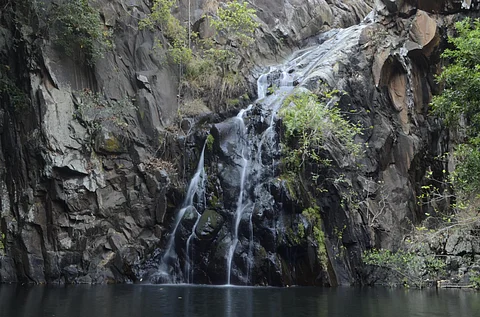
- Destinations
- Experiences
- Stay
- What's new
- Celebrating People
- Responsible Tourism
- CampaignsCampaigns
- Subscribe
- Buy Now

Recently, Archaeological Survey of India’s (ASI) epigraphical survey at Andhra Pradesh’s Sri Lankamalleswara Wildlife Sanctuary revealed three rock shelters and rock paintings along with 30 inscriptions. The six-member team found ancient inscriptions dating between the 4th to 15th centuries deep inside the Siddavatam forest range. Thirty inscriptions were found in the interior forest. These wre written in Brahmi, Nagari, Telugu scripts, and some in shell characters in Sanskrit, Praakrit, and Telugu. Furthermore, one of the three discovered rock shelters contained paintings of animals, geometric drawings, and human figures.
The Sri Lankamalleswara Wildlife Sanctuary is unique as it is the only habitat in the world where you can find the Jerdon's courser (Rhinoptilus bitorquatus), a highly endangered bird species. Outlook Traveller deep-dives into this hidden gem of Andhra Pradesh.
In 1848, British naturalist Thomas C Jerdon discovered the bird in the forests of the Kadapa district, now officially known as the YSR district. Its presence was reported till 1900, after which the bird vanished for nearly nine decades. Thought to be extinct by then, it was rediscovered in 1986 in the scrub jungles of Reddipally village.
The Jerdon’s courser is a nocturnal bird with two brown breast-bands, a yellow base with black bill, a blackish crown, broad buff supercilium, and an orange-chestnut throat patch. A narrow white crown stripe runs on top of the head. In-flight, it shows a mostly black tail and a prominent white wing bar.
The bird's reappearance prompted the creation of the Sri Lankamalleswara Wildlife Sanctuary. The 464 sq km sanctuary is composed of southern tropical dry deciduous forest in the hills, scrub forest in the plains, southern dry mixed deciduous forest, patches of dry red sanders, and Hardwickia (tropical thorn) and tropical dry everygreen forests. The sanctuary forms the catchment for the Pennar River.
The sanctuary provides a home to nearly 1,400 plant species and approximately 176 families of vegetation and living organisms. There are rare and endangered plants like red sanders (Pterocarpus santalinu) here, a tree native to the southern Eastern Ghats that has been cultivated for centuries. It is used in religious rituals as well as medicinally. The riparian vegetation is also rich in floristic value, consisting of Terminalia spp, jamun trees, wild mangoes, Anogeissus latifolia, Phoenix spp, bamboo, and more.
Besides the Jerdon’s courser, you will find amphibians like common toads and bull frogs; reptiles like the common Indian skink, green vine snake and the Indian cobra; birds such as the rufous treepie, Indian nightjar, grey francolin and Indian grey hornbill; and mammals like panthers, jackals, chinkara, chousingha and sloth bears at Sri Lankamalleswara Wildlife Sanctuary. This diversity of amphibian life, reptilian life, avian life and mammalian life supplements the richness of the invertebrate fauna found in the forest. The best time to visit the sanctuary is from October to March to see this biodiversity in all its glory.
According to the Andhra Pradesh forest department’s data, confirmed sightings of the Jerdon’s courser since its rediscovery have been remarkably scarce, confined to a handful of sites within and around the sanctuary.
A comprehensive survey spanning southern Andhra Pradesh, including Kadapa, Nellore, Chittoor and Ananthapuramu districts, revealed confirmed reports from six locations, with actual sightings in two of these, both situated in the Kadapa district. Nothing is currently known of the bird's breeding ecology and no nests or young birds have been recorded.
Despite the success of acoustic detection methods since 2002 to determine the extent of their presence, the Jerdon’s courser has not been visually confirmed for over a decade.
Take a flight to Tirupati Airport (TIR) or the train to Kadapa Junction (HX). You can take a bus or taxi from these places to reach the wildlife sanctuary.
